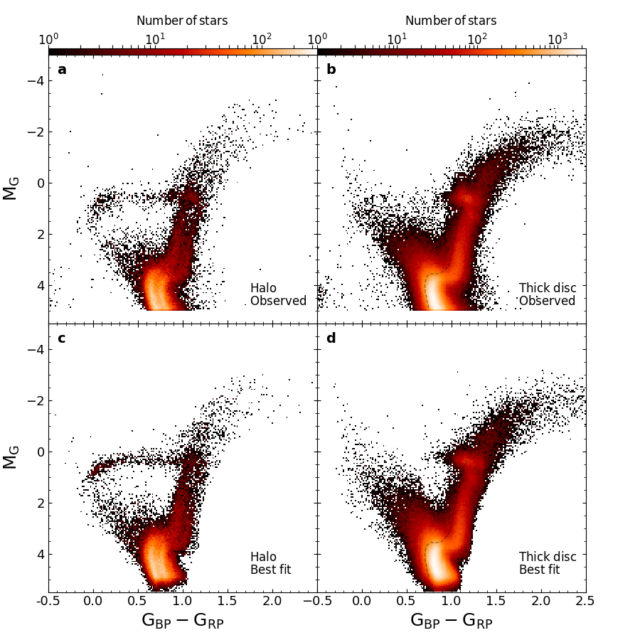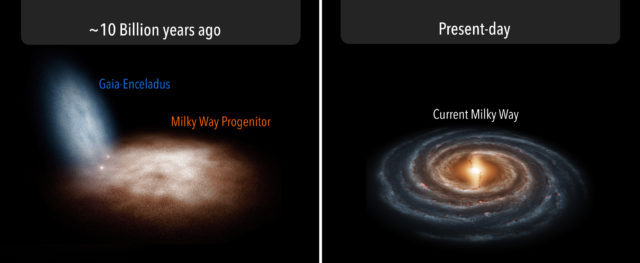The origin of our Galaxy
A group of astrophysicists (to which I have the pleasure to belong to), led by scientists from the Instituto de Astrofísica de Canarias (IAC, Spain), have recently published an article in Nature Astronomy in which the early events shaping the current view of our Galaxy, the Milky Way, have been unveiled 1. Such discovery has only been possible after the second data release of the European Space Agency (ESA) mission Gaia. Gaia is a spacecraft in orbit around the Earth that is expanding our knowledge on the stellar content of our Galaxy to volumes previously unexplored, providing data of unprecedented quality for the different Galactic components.
The Milky Way, as any other spiral galaxy, is thought to be mainly formed by: a thin disc (characterised by young stars densely packed in the plane of the Galaxy, where star formation efficiently proceeds), a thick disc (with a larger scale-height and dominated by older stars), a bulge (formed by old stars following random motions), and a stellar halo (hosting the oldest stars and stellar clusters in the Galaxy); all this embedded in a huge dark matter halo. The stellar halo is considered the natural outcome of the way spiral galaxies form and grow, and played an important role in this study to unravel the cosmic story of our Galaxy.
According to the accepted paradigm, star formation at the earliest stages of the Universe (around 13 billion years ago) favoured the creation of small systems, such as globular clusters or dwarf galaxies (groups of thousands of stars, gas and dust). It was mainly via accretion and merging of those small building blocks that the massive galaxies, now dominating the Universe, came to exist. Thanks to the analysis led by Dr. Gallart, we have been able to put our own Galaxy within that context, unveiling the chain of early events leading to its formation.
The authors made use of Gaia data to characterise the stellar content of the inner halo and thick disc components of the Milky Way via the technique named colour-magnitude diagram (CMD) fitting. The physics behind this technique is simple. When represented in a diagram of colour (x-axis) and magnitude (y-axis), stars do not fall in random positions, but follow precise distributions determined by stellar evolution. As a consequence, if compared to synthetic CMDs coming directly from the stellar evolution theory, astronomers can obtain age and metallicity distributions as well as recover the past history of a galaxy from the analysis of such observed diagrams.

In this work, the authors selected two samples of stars from the Gaia survey, one representative of the stellar halo and another one representative of the thick disc. As previously observed 2, the halo CMD clearly depicted signatures of the presence of two distinct stellar populations, one following a blue sequence (to the left of figure 1, panel a) and another one following a red sequence (to the right of the same panel a of figure 1). After the discovery of this halo double-sequence, some works claimed that the blue sequence corresponded to the debris of one of the early mergers taking place in the formation of the Milky Way, named Gaia-Enceladus 3. However, this was just half of the puzzle. What exactly was this enigmatic red sequence?
The analysis presented in this work found that both sequences are formed by stars of the same age, and older (on average) than the thick disc (see figure 2). On the other hand, both sequences differ on their stellar metallicity (amount of elements other than Hydrogen and Helium) distributions, with the blue sequence being dominated by metal-poor stars and the red sequence mainly formed by high-metallicity stars. This observational evidence, together with the outcome of cosmological simulations backing these findings, completed the picture.

Some 13 billion years ago, while the Universe was a turbulent place where star formation proceeded in a chaotic way, two stellar clumps were formed. On the one hand, the collapse of a massive cloud of gas and dust gave rise to the progenitor of our Galaxy (red sequence), whose stars soon reached high metallicity owing to its quick enrichment. On the other hand, a less massive cloud formed what we now called Gaia-Enceladus (blue sequence). In such turbulent epoch, when galactic mergers were common events, Gaia-Enceladus and the progenitor of the Milky Way merged (10 billion years ago according to this work). This violent episode was able to heat up some stars from the Milky Way progenitor as well as all the stars in Gaia-Enceladus, shaping the seed of the massive stellar halo that nowadays surrounds the Milky Way. The star formation triggered by this event was important in the build-up of the rest of the thick disc. After this chain of violent events, around 6 Gyr ago, the gas settled into a thinner configuration forming the thin disc.

It has been almost 50 years since astronomers started thinking that spiral galaxies as our own formed via this hierarchical growth of structures. However, it has only been now that we have got a complete view of the exact sequence of events forming our Milky Way galaxy.
References
- Gallart, C; Bernard, E. J.; Brook, C. B.; Ruiz-Lara, T.; Cassisi, S.; Hill, V.; Monelli, M.“Uncovering the birth of the Milky Way through accurate stellar ages with Gaia” Nature Astronomy, 22 July 2019, DOI: 10.1038/s41550-019-0829-5 ↩
- Gaia Collaboration; Babusiaux, C.; van Leeuwen, F; Barstow, M. A.; Jordi, C.; Vallenari, A.; Bossini, D.; Bressan, A.; Cantat-Gaudin, T.; van Leeuwen, M.; et al. “Gaia Data Release 2. Observational Hertzsprung-Russell diagrams” Astronomy & Astrophysics, Volume 616, A10 (2018) DOI: 10.1051/0004-6361/201832843. ↩
- Helmi, A; Babusiaux, C; Koppelman, H. H.; Massari, D.; Veljanoski, J.; Brown, A. “The merger that led to the formation of the Milky Way’s inner stellar halo and thick disk” Nature 563, Issue 7729, pp. 85-88 (2018) DOI: 10.1038/s41586-018-0625-x. ↩
1 comment
[…] Kanibalismo egintza izan zen gure galaxiaren sorrera. Tomás Ruiz-Larak aurkikuntzan hartu duen ikertzaileetako bat da: The origin of our Galaxy. […]